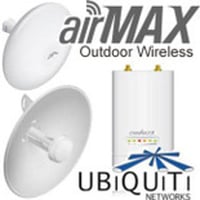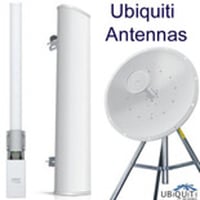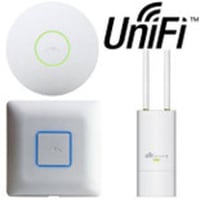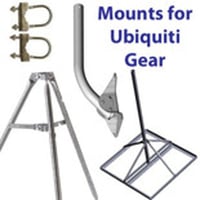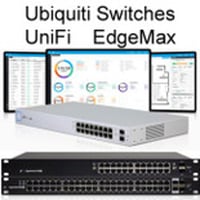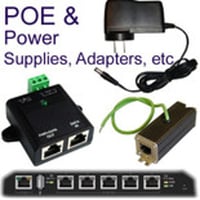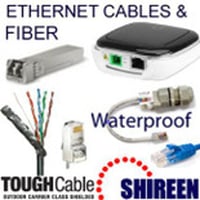Ubiquiti Products
The Product Lines of Ubiquiti:
Summary of Each Ubiquiti "Brand" / Product Line
Ubiquiti is a leading manufacturer of wireless communication and networking devices. Ubiquiti products are branded under the following categories:
AirFiber
AirFiber is a large and robust point-to-point high-performance backhaul radio transmitter and receiver. TX and RX radio and antenna are integrated into one unit, with independent channel bandwidth flexibility of between 10,20,30,40, and 50 MHz.
AirFiber is designed for frequency bands within 5.4 GHz and 6.2 GHz. This brand of products supports TDD, FDD and Ubiquiti’s HDD duplexing modes, resulting in a high spectral efficiency of up to 15.9 bps/Hz and a throughput of 20 Gbps.
AirFiber is commonly used as a backhaul in substations due to its low latency and long range.
AmpliFi
AmpliFi is a domestic mesh WiFi product. It consists of two independent mesh points and a central easy to use dual frequency 5 GHz/ 2.4 GHz WiFi router.
The two mesh radios have independent power intake from mains, and their rugged design makes them safe and continent for home use and low power sockets. The router is configured via a user-friendly mobile, PC or iOS app, and displays real-time information on a circular LCD touchscreen.
The router and mesh radios incorporate intelligent dual frequency antenna to increase WiFi range and frequency band flexibility depending on application and connectivity range. This product is designed for moderate use to improve WiFi connectivity speed and range.
AirMax
AirMax is a vast product range of CEP (customer premise equipment), access point equipment, bridge equipment, and antennas in the 5 GHz, 2.4 GHz, and 900 MHz frequency bands.
AirMax is a high-performance product line with versatile equipment for commercial and domestic wireless communication. Featured products include Dish antennas, Nano stations, sectoral antennas and Yagi antennas. Product features variations are intended to provide flexible choices for various wireless applications.
UniFi
UniFi products are sleek WiFi access points, switches, routers, and VoIP telephones for domestic and commercial use.
UniFi switches and routers share common performance and configuration features with EdgeMax, but UniFi us much easier to use and configure and intended for you in small to medium networks. UniFi WiFi access points feature easy and convenient surface mounting and configurations for home use.
The UniFi VoIP telephone is integrated with an Android OS, WiFi connectivity, a camera for video calls and captivating LCD touch screen for easy navigation.
MFi
Ubiquiti offers a wide variety of MFi Sensors for devices monitoring variables such as motion, temperature, humidity, and current. MFi sensor can be connected to Ubiquiti’s mPort IP bridge interface to create an intelligent machine-to-machine network. MFi and mPort devices are used in automated domestic and business premises.
UFiber
UFiber includes the UFiber Nano G optical network unit (ONU), UFiber optical line terminal (OLT), and UFiber loco ONU. The OLT interface with multiple UFiber optical network units to provide high-speed internet connectivity over optical fiber across distances of up to 20 KM.
The ONU has a PoE power adapter and an LCD display to show relevant real-time information to the user. The UFiber OLT is configured and managed by Ubiquiti’s web-based network management system (UNMS).
UFiber equipment is mostly used by ISPs delivering high-speed data connectivity to long-distance clients.
EdgeMax
EdgeMax products comprise of network routing and switching equipment; EdgeSwitch and EdgeRouter. Both EdgeSwitch and EdgeRouter are high throughput network tools with PoE capability and optical fiber compatibility via SFP and SFT+ ports.
The switches and routers are available in various versions featuring a different number of ports and configuration to suit different network sizes and requirements. Routers range from 3 RJ45 ports up to 8 ports. EdgeSwitch port configurations are 8, 16, 24, 28. Including the SFP and SFT+ extra ports in some of the high-end product versions.
The EdgeRouter product line is capable of handling multiple WAN connections: There are no arbitrary limitations on what can be done with the port on the EdgeRouters with the exception of the ER-PoE switch block.
With the EdgeRouter you could have 3 WAN and 1 LAN if you so desired, or up to 7 WAN with the ERPro. DHCP over VLAN is also supported.
Ubiquiti EdgeMAX Routers come in a compact fanless design so that you can work in peace and quiet. The software used in the EdgeMAX is EdgeOS, which comes with a next-generation graphical interface to make setup and control easy for any user. The Ubiquiti EdgeMax range of routers are made for smaller network applications, where you can use its inbuilt PoE to reduce infrastructure cabling costs and also save space while you are at it.
The Ubiquiti TOUGHSwitch PoE makes it easy to create less cluttered deployments and makes for a clearer design. EdgeMAX designs significantly reduce failure points and increase efficiency, making it easier to troubleshoot installations and perform maintenance.
Features of Ubiquiti EdgeMAX Routers
- Powerful Routing Performance: The routers come with some of the most powerful performance that range from a capacity of 1 million to 2 million packets every second. With such powerful performance, you can run applications and even run carrier class networks.
- Versatile Gigabit Connectivity: The EdgeMax routers have versatile Gigabit Connectivity that comes with as low as 3 independent RJ45 ports to as high as 8 ports. Most also come with two combination RJ45/SFP Gigabit ports.
- Convenient Rackmount Design: Most of the routers come in an easy rackmountable design, while some also come with the capability of wall mounting. This makes them easy to position on any available location you may have at home or at the office.
- Centralized Management: The EdgeMAX routers are managed and supported through the easy to use and configure Ubiquiti Network Management systems. This comes with an intuitive user interface where you can manage all you EdgeMAX devices.
- Deep Packet Inspection (DPI) Technology: The routers come with DPI, which allows you to track which IP addresses or applications are using the most bandwidth so that you can control your costs.
Ubiquiti EdgeSwitch and UniFi Switch Differentiated
EdgeSwitch is targeted at the ISP, carrier, and broadband market. While UniFi is targeted at small and medium-sized businesses. UniFi switches are easier to use and configure on the UniFi software platform built into the UniFi controller. UniFi switches also feature user convenience design features such as fan-less, quiet fan and slim bodies.
EdgeSwitch is a high-performance PoE+ Gigabit Ethernet switch with intelligent switching. The EdgeSwitch offers advanced Layer-2 switching protocols and Layer-3 routing features. Providing total non-blocking throughput. The EdgeSwitch features compatibility with SFP and SFT+ ports, with uplink speeds of 1Gbps and 10Gbps respectfully.
The EdgeSwitch automatically detects and receive PoE from 802.3af/at devices. At 24 volts, manual configuration must be done to enable passive 24 volts PoE.
EdgeSwitch is available in the following port configurations:
- 8-Port Up to 10 Gbps
- 16-Port Up to 18 Gbps
- 24-Port Up to 26 Gbps
- 48-Port Up to 70 Gbps
UniFi switches share several features with EdgeSwitch and is an improvement on the same. UniFi switches are high-performance non-blocking high throughput Gigabit switches. With fully managed PoE+ for 802.3af/at and 24 volts passive PoE devices.
UniFi switches provide fiber connectivity via 1Gbps SFP ports and 10Gbps SFP+ ports, that can directly connect to high-performance switches or storage servers.
UniFi switches are developed in these port and throughput configurations:
- 8- Port Up to 10 Gbps (2 SFT ports)
- 16-Port Up to 18 Gbps (2 SFT ports)
- 24-Port Up to 26 Gbps (2 SFT ports)
- 48-Port Up to 70 Gbps (2 SFT ports, 2 SFT+ ports)
ToughSwitch is a layer-2 managed switch with passive PoE capability. The switch is available in 5 port, 8 port and 16 port configurations with moderate a performance delivering at speeds of up to 1Gbps.
ToughSwitch is an earlier model of Ubiquiti switches. Newer switches – EdgeSwitch and UniFi with better performance and more feature are replacing the ToughSwitch in high demand network applications.

